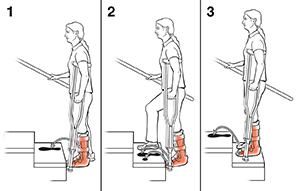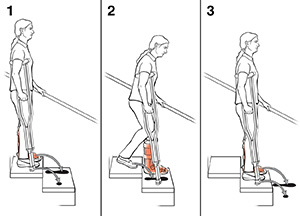Using Crutches: Up and Down Steps
When climbing up and down steps, remember this rule: Up with the good (unaffected leg) and down with the bad (affected leg). Note: If you’re supposed to keep all weight off your leg (non-weight-bearing), ask your health care provider for special instructions.
Tip
Ask a friend to carry one of your crutches while you go up or down stairs.
Take care when using stairs
-
Always use an elevator if available.
-
Have someone guard you as you learn to use stairs. A guard stands below you. They hold your belt (or a special "gait belt" you can borrow or buy) to help you if you lose your balance.
-
When there is no handrail, keep one crutch under each arm.
-
If the stairs are slippery or steep, it may be safer to lift or lower yourself from step to step while sitting. Hold both your crutches in one hand as you do so.
Going up stairs
Follow these instructions so that your weight is supported either by the crutches and the handrail or by the crutches and your stronger leg.
-
Hold the handrail with the hand on the unaffected side.
-
If a friend is not available to carry one of the crutches, tuck both crutches under your armpit on the affected side. Put both crutches in your other hand.
-
Support your weight evenly between the handrail and your crutches.
-
Put some weight on the crutches.
-
Step up with your unaffected foot.
-
Get your balance.
-
Straighten your unaffected knee and lift your body weight.
-
Bring your crutches and affected leg up.
-

If there is no handrail:
-
Hold one crutch in each hand.
-
Move your affected leg and the crutches together as a single unit.
-
Let your strong leg do the work to climb the stairs.
Going down stairs
-
Hold the handrail with the hand on your unaffected side.
-
If a friend is not available to carry one of the crutches, put both crutches in your other hand.
-
Bend your unaffected knee, moving your crutches and affected leg down.
-
Support your weight evenly between the handrail and your crutches.
-
Slowly bring your unaffected leg down.
-
Don’t hop.

Safety tips
-
Wear shoes that do not slip off. Avoid slippers, shoes with leather soles, heels, and flip-flops.
-
Wear shoes or slippers with rubber or non-skid soles.
-
Always watch out for slippery walking surfaces.
-
Check the tip or tips of your crutches daily and replace them if they are worn.
© 2000-2025 The StayWell Company, LLC. All rights reserved. This information is not intended as a substitute for professional medical care. Always follow your healthcare professional's instructions.